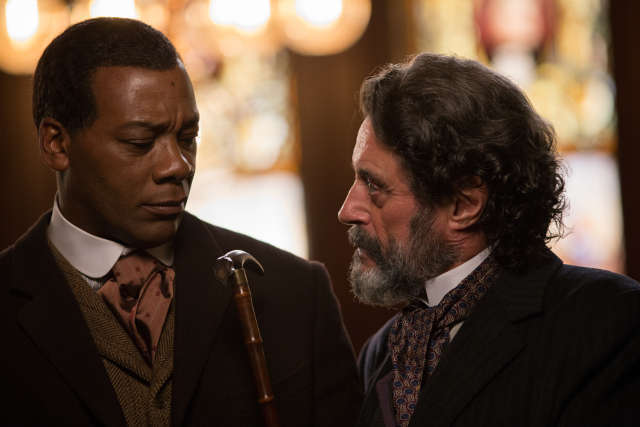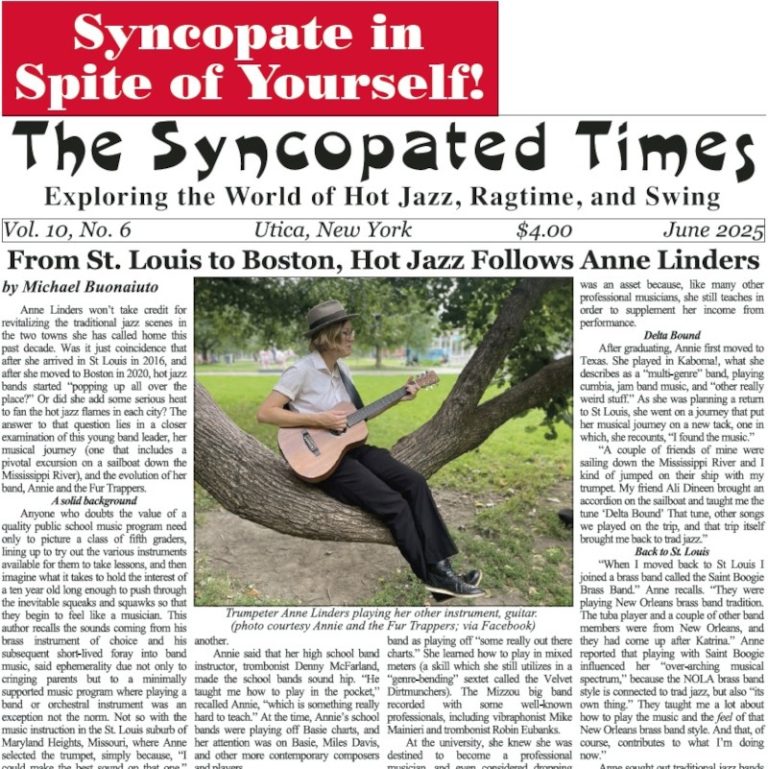Big budget films about jazz don’t come along very often. I feel a special sense of responsibility in writing about this film, as I believe that readers of Syncopated Times have a considerable emotional and intellectual investment in how it turned out-especially in how Buddy Bolden’s music is re-created by Wynton Marsalis.
Let me note at the top that there are several things that complicate the job of evaluating Marsalis’ music. First is that Marsalis has tremendous musical technique and a very characteristic sound and it’s hard not to hear that sound and that technique in what he plays.
Second, the fidelity of the music is high-as one would expect in any media created in 2019. However, in listening to early jazz, we often hear music that has not been recorded optimally and which can have a fair amount of surface noise. This has a tendency to shape our expectations.
Third, the instruments that Marsalis and the other musicians are playing on the soundtrack are top-notch and one wonders whether such instruments were available to Bolden, Cornish and the others in his band. They may have still been playing instruments that were passed out of Civil War service or gotten horns from makers like Henry Lehnert, John Heald, or even from Conn and Holton, who had cornered the market for Sousa and other high-end bands. All these elements make it a challenge for a jazz person to listen to the film soundtrack with a clean slate. However, I will cite specific details to try and make my perspective on the music as clear as possible.
In the previous Bolden piece I wrote for Syncopated Times, I gave my particular point of view concerning how he might have sounded. I took as models for his playing Bunk Johnson, Punch Miller, Wooden Joe Nicholas and I imagined the music as being in a simple blues/church-y pentatonic style, with smears and growls and some deviation from the melodies.
Marsalis says he took for his inspiration Freddie Keppard, Bunk Johnson, and King Oliver, so he and I would seem to be on similar pages. However, he also said: “I put those three styles together and I figured, ‘OK, these three musicians were all influenced by Buddy Bolden, so they took an aspect of Bolden’s personality to construct their playing. So, Bolden could play better than all three of them.’” His decision, then, was that in re-creating Bolden, he would play at a higher technical level than these other trumpeters, but I don’t think that Bolden’s technique would have superseded that of the men who came after him-jazz shows few examples of this happening.
It also seems odd that Marsalis says these trumpet players “took an aspect of Bolden’s personality to construct their playing.” This is a strange way to conceive of how playing is passed from one person to another. The music provides the impetus to learn from another jazz musician, not the personality traits. Marsalis seems to suggest that someone whose personality is quiet or introspective can’t play loudly and aggressively and vice versa.
Marsalis also says he wanted to be “energetic, authoritative and definitive.” I’d say he basically fulfills this, as his tone is loud and clear. However, it’s the growls and blues inflections Marsalis plays that ring truest to me-and truest to the period descriptions of Bolden’s playing. Often, he plays at a much more technically accomplished level, cruising in the upper register of the horn and ripping off fast arpeggios, the likes of which we don’t hear in recorded jazz until Armstrong’s West End Blues, recorded almost 30 years later. Overall, instead of the roughness of sound that seemed to mark Bolden’s playing, there is deftness and a patina of smoothness that undermines the verisimilitude of the concept.
Clarinet player George Baquet is seen in the film joining Bolden’s group. In one odd scene, the band is performing and Baquet disassembles his clarinet piece-by-piece, continuing to play on each remaining section. I guess this is supposed to be something like Hendrix playing with his teeth or behind his back. In another scene, Baquet plays in a park with Bolden and the two of them improvise what is basically a fugue, based on a classical theme (which I didn’t recognize). Possible? I guess, but a stretch.
Louis Armstrong looms large in the film, which often cuts back and forth between Bolden in the asylum and Armstrong on stage. The end of the film overlays them and has Bolden and Armstrong actually playing the same thing. This was not credible to me. We believe that Bolden’s playing led to Armstrong’s, but the music they played must have been very different.
Similarly, one musical scene-that in the abstract is well conceived-has Bolden instructing the individual players in the band as to what rhythms and “hits” he wants them to play, but the scene is less successful to me because what Bolden instructs them to do seems too advanced. This undermines the scene’s credibility, especially as the filmmakers then dissolve to Armstrong on stage in 1931, playing pretty much the same things that Bolden had instructed his band to play. There are elements that connect Bolden and Armstrong, but again, the film makes it seem like there was no evolutionary process necessary to bridge them.
There is a question hovering over Armstrong and, indeed, over the whole film, which is: how does a black musician survive financially in a white world without selling out his music (and himself)? The filmmakers give Bolden a crooked manager who colludes with a couple of vile white characters to stage brutal fights with groups of black men. The manager wants to get him into a studio to record a cylinder, which, in the movie’s code, means selling out in order to open up a white audience. Would the music of a black group like Bolden’s have found its way into white hands? Hard to say. In any case, the trope the movie uses to show Bolden’s resistance is one we’ve all heard about with Freddie Keppard who, it is said, refused to record because he thought people would steal his stuff. The film does have Bolden record (albeit sedate music) and later we see the same character who has him committed to the asylum destroy the cylinder.
The asylum plays a major role in the film, as we see often see Bolden there, either in the present, listening to Armstrong on the radio, flashing back to the past or hallucinating. The atmosphere both in the asylum and in the clubs and homes we see is dark and oppressive. The cinematography does a good job of creating this atmosphere and of visually representing the increasing fragmentation of Bolden’s mind.
As far as Bolden’s madness-the filmmakers do try to “explain” his mental dissolution, at least to some degree. The basic approach is this: Bolden observes the brutal fights staged by his manager with the corrupt white characters. The filming of these scenes is stark and disturbing. There are other scenes of violence and degradation, including the stated intent of the “Judge” to strip black people of their culture. We observe Bolden silently watching and are meant to imagine the internal disturbance these scenes are provoking.
Bolden himself is not portrayed as a saint. He’s promiscuous and there is a scene, not entirely clear, where he may or may not be shooting drugs. There’s nothing about his drinking, which, factually, seems to have been a real problem for Bolden. His bad behavior notwithstanding, I think the idea of showing him negatively impacted by this craven and violent behavior is not a bad approach. The viewer may or may not think this fully explains Bolden’s madness.
People on jazz social media are voicing negative reactions to this film. One incensed person said that it once again “paints jazz musicians as drug-ravaged savages.” I don’t take this point of view. I find this an interesting film. Buddy Bolden has an important place in jazz mythology, but we really don‘t know much about him and his music. We know that he became King Bolden and the film positively affirms his place in jazz history (although to claim, as the film does, that he “invented jazz,” well, that’s something else).
We also know that New Orleans at the turn of the century was a racist environment, with Jim Crow fully in force and I give the movie full credit for effectively showing this harsh reality. On the flip side, I feel there are ways the movie undermines itself through lapses in clarity, a lack of fully developed scenes and by using female characters as mere sexual objects. Finally, in terms of the music, the knowledgeable readers of Syncopated Times, who know their early jazz, might find that Wynton Marsalis chose an approach to Bolden’s music that only occasionally matches the edgy, rough and jagged quality of the action it inspired.
Steve Provizer is a brass player, arranger and writer. He has written about jazz for a number of print and online publications and has blogged for a number of years at: brilliantcornersabostonjazzblog.blogspot.com. He is also a proud member of the Screen Actors Guild.





















